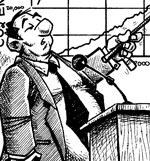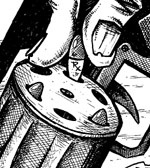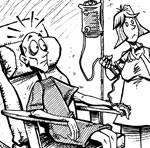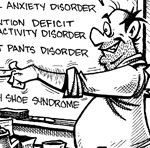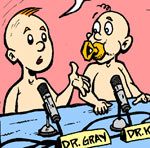How to Stop Underarm Sweating: Home Remedies for Hyperhidrosis
| Share on Facebook | Share on Twitter | Share on Google+ |
Do you ever do any of the following?
- Apply underarm antiperspirant more than once a day,
- Take a shower more than once a day to relieve underarm odor,
- Carry an extra shirt or blouse to work in case you sweat through the first one,
- Wear baggy clothes to ventilate yourself,
- Wear dark clothes to conceal underarm wetness, or
- Maintain a physical distance between yourself and others in confined spaces for fear of body odor?
If you do, you may suffer from a condition of excessive sweating called hyperhidrosis. Although accumulated sweat sometimes provides a home for fungal infections, by far the most serious problem associated with hyperhidrosis is the limitation of social interactions imposed by fear of smelling bad. Fortunately, several simple antiperspirant remedies can make hyperhidrosis a thing of the past.
Why Do We Sweat?
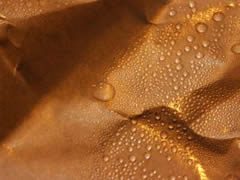 Sweating is the body's way of cooling itself. The process of perspiration is vital to human survival. Sweating is the body's "air conditioner," capable of regulating body temperature even when air temperatures soar past the levels mechanical air conditioning units can regulate.
Sweating is the body's way of cooling itself. The process of perspiration is vital to human survival. Sweating is the body's "air conditioner," capable of regulating body temperature even when air temperatures soar past the levels mechanical air conditioning units can regulate.Perspiration is regulated by the hypothalamus, a gland deep inside the brain. The front of the hypothalamus contains thermosensitive neurons that receive information from temperature sensing nerves in the skin. A sensation of heat from the skin causes the hypothalamus to send signals to the sweat glands to release perspiration that cools the surface of the skin as the sweat evaporates. Different kinds of heat signals, however, generate different levels of response.
- A sensation of elevated core body temperature, such as a fever, induces perspiration all over the body.
- A sensation of elevated skin temperature on just part of the body, induces perspiration primarily under the arms, on the hands (palmar perspiration) and feet (plantar perspiration), and on the back.
Eccrine sweat glands (also called merocrine sweat glands) are located all over the body. An adult's skin is covered with approximately 2 million eccrine glands. These glands release a clear, salty fluid in response to a signal from the hypothalamus that lowering body temperature is needed.
Apocrine sweat glands, scientists now know, actually release sweat the same way as eccrine sweat glands, by "leaking" fluid out of cells (rather than sending out packets of fluid coated with proteins). The apocrine sweat glands are concentrated under the arms, around the anus and genitals, and around the nipples. They have minimal impact on the regulation of body temperature, but they emit pheromones that help us send chemical signals to people around us.
Just how sweaty is excessive sweating? One researcher found that a single square centimeter of underarm skin might produce 0.2 cc of sweat every minute. In terms of the average adult underarm, that is the equivalent of up to a liter (4 cups) of underarm sweat every hour, which is an enormous volume of perspiration, far more than can evaporate from the skin.
Some Parts of the Body Can Get Sweatier Than Others
Perspiration can be localized to just one part of the skin. A good example of this is the reaction most people get to eating chili peppers. The sensation of gustatory heat resulting from the release of capsaicin as the pepper is being chewed triggers a specific nerve reflex that causes sweating on the forehead, tearing from the eyes, and runny mucus from the nose.
People who have poorly controlled type 2 diabetes sometimes develop a condition called neuropathy, in which the protective layers of nerve fibers literally "caramelize" as they react with glucose in the blood. These sufferers of diabetic neuropathy will often develop a similar kind of reflex to eating high-carbohydrate foods, causing gushing of sweat from the forehead, face, and neck.
Shingles also causes localized sweating near its blisters as the shingles virus travels up the nerve leading from the spine to a sweat gland. Since shingles most often break out of the face, they most often cause excessive sweating of the face and forehead.
The most common localized sweating is the sweating that causes sweaty, smelly hands and feet. The nerves that control the sweat glands in the hands and feet connect to a different part of the hypothalamus, away from the nerves that control the sweat glands on the rest of the surface of the body. This part of the hypothalamus responds more strongly to stimulation by emotional stress, while the rest of the hypothalamus responds more strongly to stimulation by temperature. Emotional stress may make the hands and feet gush perspiration while the rest of the body stays dry.
What Causes Excessive Underarm Sweating?
If you were to ask an academic specialist in the physiology of perspiration why some people pour perspiration from under the arms, you probably would get an answer on the lines of "Oh, we know that there really aren't any health conditions that cause excessive underarm perspiration." But we all know people-or we are the people-who sweat profusely from the armpits. What really is going on with excessive underarm perspiration?
Doctors would typically describe excessive hyperhidrosis symptoms as physiological, symptomatic, or idiopathic.
- Physiological sweating occurs simply as a response to perceived heat. This can be a response to the ambient air temperature, or a response to heat in folds of skin.
- Symptomatic sweating occurs in response to a disease process. The conditions that cause symptomatic sweating are rare. They include pheochromocytoma, a tumor of the adrenal glands, Ross syndrome (causing profuse perspiration on some parts of the skin and an absence of perspiration on others, along with diminished reflexes of the pupils and the tendons), Sudeck's syndrome (also known as complex regional pain syndrome), or hyperthyroidism, a condition of over-activity of the thyroid gland. All other things equal, you have less than a 1% chance of developing hyperthyroidism and less than a 0.001% chance of developing the other conditions that cause symptomatic sweating. Symptomatic sweating is also caused by leukemia, lymphoma, many kinds of cancerous tumors, Parkinson's disease, malaria, Lyme disease, and some other relatively rare infections. Hot flashes can occur in women who have low estrogen levels (primarily during menopause) and men who have low testosterone levels (at any time of life).
- Idiopathic sweating is due to causes other than heat or disease. Idiopathic sweating is a side effect of many medications, including aspirin, antidepressants, amphetamines, alcohol, and insulin.
The solution for physiological sweating is very straightforward. Turn on the air conditioner! Simply finding a cooler location will help reduce sweat.
Symptomatic sweating resolves with disease treatment you work out with your health care provider. And if you take one of the medications that induces heavy perspiration, at the very least you will know to use extra antiperspirant.
How Antiperspirants Work
There is a common confusion between antiperspirants and deodorants. Antiperspirants stop sweating. If there is no sweat, then odor-causing bacteria will not have a medium in which to grow. But because perspiration itself has no odor, antiperspirants will not reverse body odor once it occurs.
Deodorants stop odor. They kill the bacteria that cause odor but they do not stop perspiration. Most of the time, the place to start is with an antiperspirant.
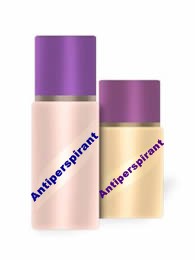
Most antiperspirants contain a chemical called aluminum chloride hexahydrate. This chemical changes the chemistry of sweat glands so that they retain fluid rather than releasing it as sweat. Antiperspirants are typically only used to treat the apocrine sweat glands under the arms, or less commonly around the genitals or nipples, where odor-causing bacteria feed on both liquid perspiration and fatty secretions that carry pheromones.
Aluminum-based antiperspirants in a 20% strength (available with a prescription) actually don't have to be used every day, but they are effective only in milder cases of underarm hyperhidrosis. For persistent cases of hyperhidrosis, modern medicine offers a variety of increasing invasive procedures.
Medical Interventions for Hyperhidrosis
Another way to shut down the sweat glands is to shut down the nerves that activate them. This can be done with a class of medications that are known as anticholinergics, such as propantheline, which is also used for irritable bowel syndrome and irritable bladder syndrome. The problem with using an anticholinergic drug is that it shuts down the activity of the sympathetic nervous system all over the body, so turning off the process of perspiration may also stop urination, tear secretion, and salivation, and also cause constipation.
It is possible to shut down a smaller number of nerves with Botox injections. A Botox shot stops the production of neurotransmitters in a radius of about an inch (25 mm) around the injection site. Botox is expensive, up to US $500 per injection, and the injections can be very painful. Muscles around the injection site can be paralyzed, including the muscles of the shoulder and the upper arm. The effects of the injection wear off after 3 to 6 months.
There is a surgical procedure to cut the nerves leading to the sweat glands under the arms. The side effect of surgery to stop sweating on one part of the body usually is increasing perspiration somewhere else! Surgery for hyperhidrosis simply does not always work. So what can you do if you don't want to use heavy-duty antiperspirants, you don't want to get Botox injections, and you don't want surgery. Here are 10 home remedies for hyperhidrosis.
Eight Effective Home Remedies for Hyperhidrosis
- Wear loose-fitting clothing. Tight-fitting clothing collects sweat and makes you sweat more because the cooling effect of evaporation is limited.
- Avoid spicy foods, chocolate, garlic, and peppers during the day. Although these foods primarily stimulate sweating from the face and neck, they can also increase underarm perspiration.
- Wash every nook and cranny of your body every day. This won't stop perspiration, but it will reduce bacterial odor.
- Don't use antiperspirants under the arms that are designed for use on feet and hands. Aluminum chloride hexahydrate comes in up to a 30% strength for use on sweaty feet and hands. That concentration of the aluminum ingredient will cause skin irritation under the arms. Don't use any product containing more than 15% aluminum chloride hexahydrate under your arms.
- Try a sage tea. Steep 3 tablespoons (approximately 40 grams) of dried sage leaves ("rubbed" sage leaf is harder to mix with the water) in 1 cup (240 ml) of warm tap water for at least 8 hours. Splash the mixture under the arms every morning and allow to dry before applying any other antiperspirant or deodorant. The tannins in the sage tea crosslink or "tan" proteins in the skin that reduce the flow of perspiration. A clinical trial sponsored by the Isfahan School of Medical Sciences in Iran found that using sage tea on underarm skin every day for six weeks reduced underarm perspiration an average of 37%. The sage tea antiperspirant was effective for men, women, and children as young as age 8.
- Take up swimming in the coldest pool you can find. Not only will you relieve any heat stress, you will also burn more calories during your exercise routine.
- Wear clothes made of natural fibers such as cotton and linen. It's important that the fabric "breathes" so your sweat dries more quickly and your body doesn't not need to produce as much sweat.
- Don't panic if you forget to use your antiperspirant. Aluminum-based antiperspirants work even if you wash the skin up to about 4 days. They shut off sweat glands until the skin above the glands produces a new layer.

It's actually possible to stop excessive sweating by drinking sage tea, but an adult would need to drink about a liter (2 cups) a day to get significant relief. And there are also other natural approaches to controlling underarm sweating that actually work.
One is homeopathy. I've written about my own misgivings about homeopathy and how I changed my mind after I was privileged to spend some time observing at the clinic of the late, great French allergist and homeopathic researcher, Dr. Jacques Benveniste. I'll just say that since there are no side effects of homeopathy for excessive perspiration, and the product I'm going to recommend here comes with a one-year money-back guarantee, why not try it?
- Argentum nitricum (silver nitrate) is a traditional remedy for "nerves." The people who benefit most from taking it typically are intolerant of heat and may have a craving for sweets. It is used to treat symptoms of stress that cause fluid production, including heavy perspiration, but also mucus, gas, and runny bowels.
- Castoreum (from the castor bean that is used to make castor oil) treats any kind of sour-smelling secretion. This remedy is for odor rather than for excessive sweating.
- Lupulus is the homeopathic remedy derived from hops. Before hops were used to flavor beer, they were an herbal remedy for insomnia and also for stomach upset. In the context of stopping excessive perspiration, they are intended to reduce excessive "apocrine" perspiration both under the arms and under the belt.
- Natrium muriaticum is a homeopathic remedy for a very specific kind of emotional pain that most homeopathy texts describe in great detail. In this context, it is the remedy needed for sweating that comes on in tense social situations.
- Syphilinium was used in classical homeopathy, as you might guess, to treat syphilis. In this context, however, it is intended for nighttime control of perspiration.
You don't have to track down and buy all five homeopathic remedies separately. Native Remedies offers all five homeopathic solutions for excessive perspiration in a single product, Sweat-Less. And while you are gradually sweating less, there is also a product to help you generate less odor. It's called DeodoRite.
- Calcarea sulphuricum is included to stimulate the lymphatic system, "drying up sweat glands from the inside out."
- Carduus mar is a homeopathic preparation of milk thistle, the liver herb. Here it is used to prevent sulfurous odors.
- Gallium, in this formula, is especially added to prevent odor from perspiration in the ano-genital area.
- Magnesia phosphoricum is the homeopathic equivalent of talcum powder, only its taken orally-and it doesn't contain any powder. This remedy is included for cooling of the skin and relief of prickly heat.
- Mercurius vivus is added to "quicken" resolution of symptoms.
- Silicea is added for removal foreign matter from the skin. Homeopathic physicians would also advise against using silicea or any formula containing silicea by people who have any kind of implant, such as a pacemaker, a pin in a bone, breast enhancement, or an artificial joint.
Frequently Asked Questions About Underarm Hyperhidrosis
Q. Won't underarm sweat pads take care of hyperhidrosis?
A. Not if each armpit is producing 500 cc (2 cups) of sweat every hour. However, sweat pads and other garment shields are a good idea when you wear expensive clothes or clothes that show sweat. Just don't expect them to be enough to soak up sweat when you are in a hot, humid, stuffy room.
Q. What is "axillary hyperhidrosis?"
A. Excessive sweating under the arms.
Q. What is the difference between bromhidrosis and hyperhidrosis?
A. Bromhidrosis involves an offensive odor, while hyperhidrosis involves excessive sweat. Hidradenitis is a recurring infection of the apocrine sweat glands, usually manifesting itself as yellow-topped pimples.
Q. Is hyperhidrosis an inherited condition?
A. No, only about 25% of people who have hyperhidrosis have a family member who also has the condition, Israeli researchers report. People of Asian heritage tend to develop the condition earlier, even in early childhood, while people of most other racial heritages tend to develop excessive sweating either at puberty or with hormonal changes (menopause in women or testosterone deficiency in men) after midlife.
Q. What is "ETS?"
A. Endoscopic thoracic sympathectomy is hyperhidrosis surgery. The surgeon makes tiny, endoscopic incisions in the armpit to install titanium clips to block transmissions of signals from the central nervous system to sweat glands. The procedure is conducted under anesthesia and generally pain is minimal.
Q. Does iontophoresis work for underarm sweating?
A. Iontophoresis is a procedure in which sponges are soaked in tap water and then wrapped around metal electrodes inserted into sweat glands. An electrical current is passed through the electrode and the sponge until there is a stinging sensation. The procedure is repeated several times a week until enough sweat glands are destroyed that excessive sweating is reduced.
It is possible to use this procedure on the armpits, but it is difficult to keep the sponges from dripping so that the current flows all over the skin with the flow of water. Moreover, destroying sweat glands under the arms may just lead to excessive sweating on some other area of the body that is even more difficult to control.
Q. Can hyperhidrosis be treated with radiation?
A. Yes, but this is in effect treating an overactive sweat gland as if it were a cancer. And since radiation can actually cause cancer, very few doctors anywhere would consider offering this procedure.
Q. I heard sometimes people are put in microwaves to stop excessive sweating?
A. No, dermatologists are experimenting with a hand-held microwave generator called miraDry. The dermatologist injects a temporary tattoo made with metallic ink into the armpit, and then holds the microwave generator over the armpit to microwave sweat glands. The procedure is more painful than Botox injections and not covered by insurance, but preliminary reports are that it stops excessive underarm perspiration for at least a year.
Q. Does breast cancer cause underarm sweating?
A. Before the tumor is treated, there may be additional perspiration around the nipples. If the breast is removed, then there may be compensatory sweat production under the arms. Add to this the hot flashes caused by treatment with tamoxifen (Nolvadex) for estrogen-sensitive breast cancers, and excessive underarm perspiration is a common problem for many women who have had breast cancer.
Selected Sources:
Bernstein G, Hanke CW. Safety of liposuction: a review of 9,478 cases performed by dermatologists. J Dermatol Surg Oncol 1988; 14: 1112-4.
Bouman HD, Grunewald-Lentzer EM. The treatment of hyperhidrosis of hands and feet with constant current. Am J Phys Med 1952; 31: 158-69.
Brand CU, Brun del Re CE, Kernland K, Hunziker T. Leitungswasser-Iontophorese als Langzeitbehandlung der Hyperhidrosis palmoplantaris. Akt Dermatol 2000; 26: 366-70.
Bretteville-Jensen G. Radical sweat gland ablation for axillary hyperhidrosis. Br J Plast Surg 1973; 26: 158-62.
Brin MF. Botulinum toxin: chemistry, pharmacology, toxicity and immunology. Muscle Nerve Suppl 1997; 6: 146-68.
Bushara KO, Park DM, Jones JC, Schutta HS. Botulinum toxin: a possible new treatment for axillary hyperhidrosis. Clin Exp Derm 1996; 21: 276-8.
Castells-Rodellas A, Moragon-Gordon M, Ramirez-Bosca A. Efecto de la bornaprina en las hiperhidrosis localizadas. Med Cutan Ibero Lat Am 1987; 15:303-5.
Drechsler S. Einsatz von Bornaprin bei der Hyperhidrosis. Dt Derm 1996; 44: 388.
Edmondson RA, Banerjee AK, Rennie JA. Endoscopic transthoracic sympathectomy in the treatment of hyperhidrosis. Ann Surg 1992; 215: 289-93.
Harth W, Linse R. Botulinophilie. Die neue Lifestyle-Venenophilie. Hautarzt 2001; 52: 312-6.
Heckmann M, Ceballos-Baumann AO, Plewig G. Botulinum toxin A for axillary hyperhidrosis (excessive sweating). N Engl J Med 2001; 344: 488-93.
Hill AC, Baker GF, JansenTG. Mechanism of action of iontophoresis in the treatment of palmar hyperhidrosis. Cutis 1981; 28: 69-71.
Hoelzle E, Alberti N. Long-term efficacy and side effects of tap water iontophoresis of palmoplantar hyperhidrosis-the usefulness of home therapy. Dermatologica 1987; 175: 126-35.
Karamfilov T, Konrad H, Karte K, Wollina U. Lower relapse rate of botulinum toxin A therapy for axillary hyperhidrosis by dose increase. Arch Dermatol 2000; 136: 487-90.
Kisten P, Kahle D, Hineke H. Clinical testing of emphratic action of bornaprine. A double-blind study. Akt Neurol 1979; 6: 111-6.
Levit F. Simple device for treatment of hyperhidrosis by iontophoresis. Arch Dermatol 1968; 98: 505-7.
Lillis PJ Coleman WP. Liposuction for treatment of axillary hyperhirdrosis. Dermatol Clin 1990; 8: 479-82.
Lin TS, Fang HY, Wu CY. Repeat transthoracic endoscopic sympathectomy for palmar and axillary hyperhidrosis. Surg Endosc 2000; 14: 134-6.
Morgan K. The technique of treating hyperhidrosis by iontophoresis. Physiotherapy 1980; 66: 45.
Naver H, Swartling C, Aquilonius SM. Palmar and axillary hyperhidrosis treated with botulinum toxin: one-year clinical follow-up. Eur J Neurol 2000; 7: 55-62.
Raulin C, Petzoldt D. Behandlung der Hyperhidrosis. Dtsch med Wschr 1988; 113: 1860.
Reinauer S, Neusser A, Schauf G, Hoelzle E. Iontophorese with alternating current and direct current offset (AC/AD iontophoresis): a new approach for the treatment of hyperhidrosis. Br J Dermatol 1993; 129: 166-9.
Rompel P, Peros I, Petres J. Langzeitergebnisse nach subkutaner Schweibdrüsenkürettage bei Hyperhidrosis axillaris. Zentralbl Haut Geschlechtserkr 1994; 164: 169.
Sato K, Timm DE, Sato F, Templeton EA, Meletiou DS, Toyomoto T, Soos G, Sato SK. Generation and transit pathway of H+ is critical for inhibition of palmar sweating by iontophoresis in water. J Appl Physiol 1993; 75: 2258-64.
Schara R. Behandlungsstrategie bei Hyperhidrosis. Eine kritische überprüfung der Therapie mit einem Parkinson-Medikament. TW Dermatologie 1993; 23: 277-8.
Schempp CM, Czech W, Schüpf E, Simon JC. Leitungswasser-Iontophorese bei der Behandlung dyshidrotischer mit Hyperhidrosis assoziierter Palmoplantarekzeme. Akt Dermatol 1996; 22: 198-201.
Scott AB. Botulinum toxin injection of the eye muscles to correct strabism. Trans Am Ophthalmol Soc 1981; 79: 734-70.
Shelley WB, Talanin NY, Shelley ED. Botulinum toxin therapy for palmar hyperhidrosis. J Am Acad Dermatol 1998; 38: 227-9.
Solomon BA, Hayman R. Botulinum toxin type A therapy for palmar and digital hyperhidrosis. J Am Acad Dermatol 2000; 42: 1026-9.
Swinehart JM. Treatment of axillary hyperhidrosis: combination of starch-iodine test with tumescent liposuction technique. Dermatol Surg 2000; 26: 392-6.
Wollina U, Uhlemann C, Elstermann D, Köber L, Barta U. Therapie der Hyperhidrosis mittels Leitungswasseriontophorese. Hautarzt 1998; 49: 109-13.
Zuber M, Sebald M. Botulinum antibodies in dystonic patients treated with type A botulinum toxin: frequency and significance. Neurology 1993; 43: 1715-8.
-
Skin CareMen Skin Care
-
Free ResourcesFree eBooks
-
Every person is a God in embryo. Its only desire is to be born.Deepak Chopra
-
What We RecommendIf you do an analysis of the ingredients in a bottle of
 Total Balance and compare with other products you will find that it provides exceptional value for money…even against simple mass produced products with lower bottle costs.
Total Balance and compare with other products you will find that it provides exceptional value for money…even against simple mass produced products with lower bottle costs.
-




